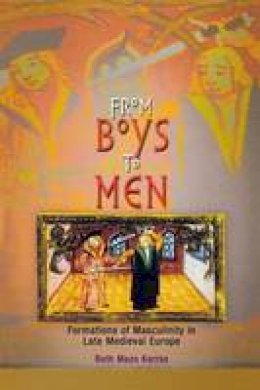8%OFF

Stock image for illustration purposes only - book cover, edition or condition may vary.
From Boys to Men: Formations of Masculinity in Late Medieval Europe (The Middle Ages Series)
Ruth Mazo Karras
€ 31.99
€ 29.55
FREE Delivery in Ireland
Description for From Boys to Men: Formations of Masculinity in Late Medieval Europe (The Middle Ages Series)
Paperback. "The book .. will find a broad audience. It would work well in the classroom.. Effectively combating the nonspecialist's view of the Middle Ages as a monolithic and static society, it will encourage more subtle thinking about gender identities in the past and in the present.-American Historical Review Series: The Middle Ages Series. Num Pages: 256 pages, black & white illustrations. BIC Classification: 1D; 3H; HBJD; HBLC; JFSJ2. Category: (U) Tertiary Education (US: College). Dimension: 226 x 151 x 17. Weight in Grams: 380.
While the social identity of women in medieval society hinged largely on the ritual of marriage, identity for men was derived from belonging to a particular group. Knights, monks, apprentices, guildsmen all underwent a process of initiation into their unique subcultures. As From Boys to Men shows, the process of this socialization reveals a great deal about medieval ideas of what it meant to be a man-as distinguished from a boy, from a woman, and even from a beast. In an exploration of the creation of adult masculine identities in the fourteenth and fifteenth centuries, From Boys to Men takes a close look at the roles of men through the lens of three distinct institutions: the university, the aristocratic household and court, and the craft workshop. Ruth Mazo Karras demonstrates that, while men in the later Middle Ages were defined as the opposite of women, this was never the only factor in determining their role in society. A knight proved himself against other men by the successful use of violence as well as by successful control of women. University scholars proved themselves against each other through a violence that was metaphorical and against other men by their Latinity and their use of the tools of logic and rationality. Craft workers proved their manhood by achieving independent householder status. Drawing on sources throughout Northern Europe, including court records and other administrative documents, prescriptive texts such as instructions for dubbing to knighthood, biographies, and imaginative literature, From Boys to Men sheds new light on how young men were trained to take their place in medieval society and the implications of that training for the construction of gender in the Middle Ages. Rescuing maleness from its classification as an ungendered category, From Boys to Men unravels what it meant to be men in a womanless context, revealing the common threads that emerge from the study of young manhood in various disparate institutional settings.
Product Details
Publisher
University of Pennsylvania Press
Format
Paperback
Publication date
2002
Series
The Middle Ages Series
Condition
New
Weight
369g
Number of Pages
256
Place of Publication
Pennsylvania, United States
ISBN
9780812218343
SKU
V9780812218343
Shipping Time
Usually ships in 7 to 11 working days
Ref
99-1
About Ruth Mazo Karras
Ruth Mazo Karras is Professor of History at the University of Minnesota.
Reviews for From Boys to Men: Formations of Masculinity in Late Medieval Europe (The Middle Ages Series)
A founding document in the field of men's history. -Jo Ann McNamara, author of Sisters in Arms Part of the achievement of this fine book is the care with witch it unfolds material and textual evidence of male and female relations. No less valuable is its subtle acknowledgment that modern preoccupations with gender and sexuality can prompt overreading of sources. -Journal of English and Germanic Philology Extremely welcome. -History The book, well written and accessible, will find a broad audience. It would work well in the classroom, either as a source of lecture material or as assigned reading. Effectively combating the nonspecialist's view of the Middle Ages as a monolithic and static society, it will encourage more subtle thinking about gender identities in the past and in the present. The book also sets a research agenda for specialists.-American Historical Review
